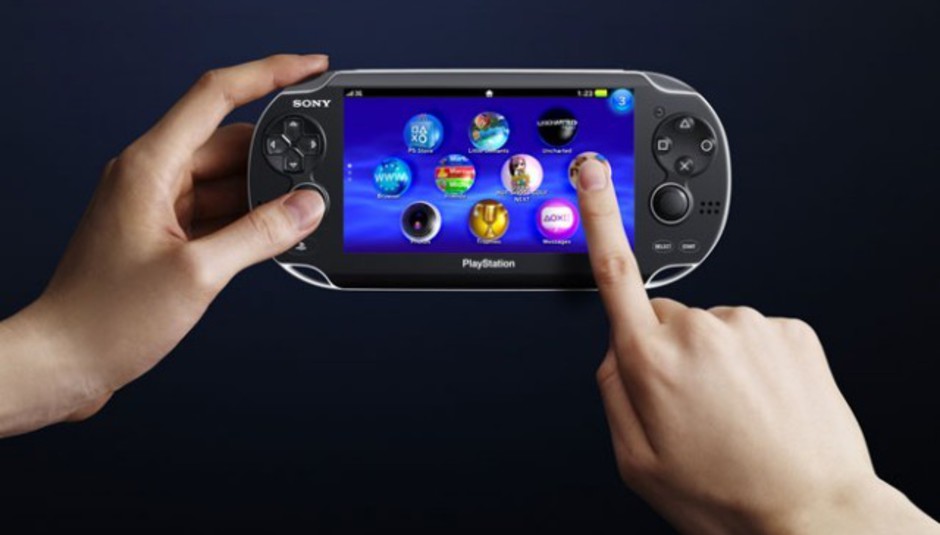Enter, stranger. Here be words on video games: the bright moving lights on your tellybox when you’re not watching Take Me Out or Time Team. Sometimes criticism is proffered (this month: yes, some); others, I may just run a bunch of YouTube clips. You’re just gonna have to keep coming back to see how it shakes down.
TRAILERS TO AMAZE THE EYES (THIS IS THE PREVIEW BIT)
This month I’m letting the games themselves do most of the preview talking. Just look at these beauties. Look at them! They are pretty…
The Last of Us
Due out (perhaps) in time for Christmas, Naughty Dog’s not-Uncharted title-in-the-works looks good enough to eat; assuming you like the taste of weird, fungus-sprouting zombies. With the lead designer for Enslaved on board, it’s little wonder The Last of Us looks amazing; if it plays brilliantly, too, this will be the perfect excuse to pick up a PS3 if you’re yet to, as (like Uncharted) it’ll be exclusive to Sony’s current-gen machine.
TRAILER
BioShock Infinite
How many ways can you spell W-A-N-T? Fingers crossed that the third title in the BioShock franchise, albeit one not completely connected to the underwater setting of the previous pair, makes it into stores this side of Christmas. Good to go, when it’s good to go, for 360, PS3 and Windows.
TRAILER
Resident Evil 6
This one has a release date, but don’t go holding your breath: it’s not out ‘til November 20, for 360, PS3 and Windows. What’s the best Resi to date? Some’ll say 2, others 4; some will go all the way back to the first title on the PlayStation. But it’s unlikely anyone really cares for the fifth game, which was… a bit lame, really. Here’s hoping that this reveal trailer, which hints at the eerie murk of earlier games, and to a city setting, returns the Resi series to its gruesome glory.
TRAILER
Prey 2
I’ll be honest: I never played the first Prey, released in 2006 to a relatively positive reception. Perhaps I should though, as this (admittedly old, dating from E3 2011, but still super-looking) trailer makes me think: Mass Effect without all the RPG bits, COOL. Don’t get me wrong, I love Mass Effect’s RPG bits, and can’t wait for ME3; but sometimes you just want to shoot a load of shit up real good without having to fanny about winning the loyalty of some robot that used to hate on you anyway. Prey 2 lands sometime in Q2/Q3, for Windows, 360 and PS3.
TRAILER
Transformers: Fall of Cybertron
The sequel to Activision’s well-received 2010 title War For Cybertron finds the Autobots on the receiving end of a right kicking from those Decepticon nasties. But, as this trailer reveals, there may be salvation in the shape of a certain monster-shaped brute by the name of… yep, you guessed it. Michael Bay may have shied away from including them in his three-hour assaults of blinding colours and bombastic effects, but at least one Dinobot is gearing up to munch metal on Fall of Cybertron. At least, I think so. That IS Grimlock, right? Breathing fire like a bad-ass. Out in the autumn for the 360 and PS3.
TRAILER
Mass Effect 3
This new ‘Take Back Earth’ trailer premiered just the other day, and it makes me want to cry, it’s that amazing. ME3 might be released on March 9, but with more hours of gameplay than you can chuck a bucket of regular RPGs at, I can guarantee you I won’t be getting a tan this summer. Hopefully there will be a review of this in next month’s column (albeit a scratched-the-surface summary, as I don’t have 36 hours in my days).
TRAILER
SHINY NEW THINGS TO SPEND YOUR MONEY ON (THIS IS THE REVIEW BIT)
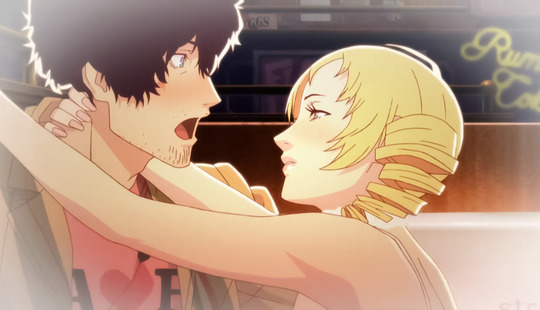
Catherine
(Altus/Deep Silver; Xbox 360, PlayStation 3)
Whenever I see that name, I can’t help but be reminded of the PJ Harvey song, from my personal favourite Peej LP, Is This Desire?. And it could well be that Tokyo-based developers Altus are familiar with the number, too, as one of its lines – “Gave you my heart / You left the thing stinking” – says much about the narrative of this puzzling little title.
You play as 32-year-old Vincent, an unshaven computer programmer who likes nothing more than slinging back some rum-and-colas of an evening down at a bar called The Stray Sheep. He’s had the heart of his girlfriend, Katherine, for some years without making an honest woman of her; and he’s about to trample all over it by straying from monogamy with a pretty young thing called Catherine. So far, so whatever – but not only is Catherine far from what she seems (likewise the barmaid, Erica), but Vincent is being haunted by some pretty horrific nightmares. It’s these dream sequences that deliver the gameplay element of Catherine – more on that, later – while the plot is gradually fleshed out by sudden supernatural turns and the deaths of numerous young men in their sleep. As Vincent converses with the patrons of The Stray Sheep each night, the severity of his predicament becomes apparent. These aren’t just dreams he’s having – they could be the death of him. And that landlord, there’s something decidedly woolly about him…
I won’t say anymore on Catherine’s story for fear of spoiling what is a genuinely decent yarn, the sort of moralistic plot that’d make for a fine TV movie (indeed, it’s framed as such at the beginning and end of proceedings, hence the Golden Playhouse logo in the corner of the screen). It might get a bit hammy in places, but it’s a well-paced tale and the voice acting is of a high standard throughout, likewise the graphical presentation (cut scenes are handled by celebrated anime house Studio 4°c). It does enough between each nightmare section to keep the player interested in what comes next – the problem, though, is navigating the levels to reach these chapters.
Catherine’s a puzzle game at its core, as Vincent finds himself having to scale almighty walls of movable blocks (pictured, below). Push or pull these blocks to ascend to the exit to each stage – sounds easy, right? And for the first few levels it certainly is: new types of block (ice, cracked blocks that crumble, spring blocks that launch you upward, monster blocks that try to eat you, bomb blocks that destroy surrounding blocks, etc) are introduced as the game progresses, but the difficulty curve is poorly managed. When Vincent is simply climbing, this is fine; but when he’s being chased by one of the game’s various bosses, which appear at the end of every level, controllers can get tossed. I must have been stabbed into itty-bitty pieces by ‘Doom’s Bride’ several dozen times before completing said stage – which arrives well before the game’s halfway mark.
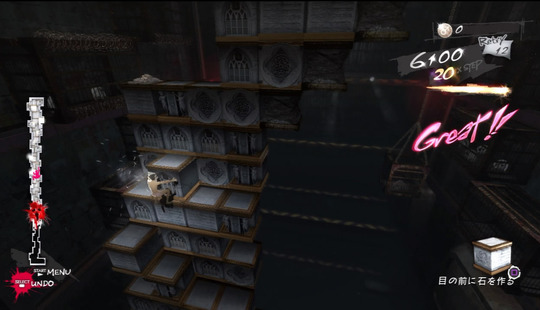
Persist though – or cheat a little and unlock a Very Easy mode (only go here when you’re really stuck, as the game practically plays itself at this difficulty) – and Catherine becomes a joy. The trick is sticking with it long enough for the numerous, and sometimes very complex, strategies for climbing to become second-nature; that, and getting to grips with the twitchy controls, which can leave Vincent, through little fault of the player, in irretrievable positions (although, on Normal and Easy mode, you can undo moves at the press of a button). Once you’re arranging blocks to create stairways in a heartbeat, and shimmying along edges to reach new paths rather than struggling for more ‘direct’ routes, everything clicks and suddenly the praise this game received on its Japanese/North American release in 2011 makes sense. The faster you go, the higher your score, so speed-runs provide interest after the game’s eight different endings have been seen (these are dependant on how you answer a series of morals-testing questions between levels, and also how you react to the attentions of Katherine and Catherine via emails). Finish the game once and you unlock the two-player Coliseum mode – here, you can race against a friend to the top of previously conquered stages.
Overall, Catherine is a very original vision, its puzzle aspect borrowing from several preceding titles but somehow presenting a challenge that’s a truly singular experience. It feels like its developers put a lot of love into it – and several little touches, such as an arcade version of the main game in The Stray Sheep (use it, as it can help you with techniques) and booze trivia once you’ve finished a glass, round it out into a recommendable package. If you’re prepared to fight through frustration (truly, even on Easy this is incredibly tough) then you’ll find a quirky and quality game here; but if patience is at a premium when you’ve a pad in hand, it’s probably best to move along to something less likely to leave you a blubbering wreck with bunches of your own hair in your white-knuckled fists.

The Darkness II
(Digital Extremes/2K Games; Xbox 360, PlayStation 3, PC)
The first game to be based on Top Cow’s comic series The Darkness arrived with seemingly little fanfare back in 2007, but proved to be one of that year’s best first-person shooters, mixing ‘magic’ in the form of Darkness powers with traditional running-and-gunning down-the-sights action, wrapped up in a story that compelled the player to reach its bloody conclusion. This sequel, which arrives alongside news that a Darkness movie remains on the cards, looks to up the ante in every respect: the combat is more furious, the game’s narrative chases forwards at double time, and the aesthetics have been overhauled entirely. Gone is the photo-realism of the first game, along with the grotty, grimy surrounds of New York’s subways and World War II trenches; instead, it’s a Borderlands/XIII-recalling cel-shaded style that has been employed, high on contrast. And, mostly, the new visuals work splendidly well.
Certainly the cartoon-like presentation sweetens the sourness of what unfolds on screen: brutal murders, heads popped from shoulders, enemies torn in half by The Darkness’ demon arms protruding from the protagonist, gangster boss Jackie Estacado. Jackie’s a possessed man – and his demons come to life with incredibly violent consequences. This title is relentless in its pursuit of the visceral, rarely pausing for a moment of calm outside of some is-it-just-a-dream asylum sections (pictured, below). The first game perhaps balanced the bombastic with the becalmed a little better, at least during its opening hours when Jackie’s girlfriend was around. Said love interest, Jenny Ramano, is a constant presence throughout The Darkness II, despite her execution in the first game. Jackie sees her ghost early on, after a restaurant shoot-out that ultimately forces him to unleash the savage Darkness powers he thought were under control. (The Darkness is magnificently voiced, for the second time, by Faith No More frontman Mike Patton.) A few flashbacks later and Jackie’s convinced that The Darkness has her soul trapped, and sets about rescuing Jenny in the afterlife – his progress is driven as much by guilt for not saving her first time around as it is a desire for carnage, making this an unexpectedly tender love story, albeit one for adrenaline-junkie gamers.
The Darkness II has rightly received criticism elsewhere for its short solo campaign – but while the single-player experience is wrapped up in a couple of evenings’ play, and would have benefited from an extra scenario/stage or two, Digital Extremes have included a co-op (optional) ‘Vendettas’ mode. The story of this mode takes place alongside events of the main narrative, with the player assuming control of one of four characters charged with recovering Darkness relics (collectibles found throughout the game) for Jackie. These are stashed in Jackie’s panic room, at the mansion that acts as a pre-mission hub – until, that is, it’s attacked by the game’s primary antagonists: The Brotherhood. These guys are out to take The Darkness for themselves, their leader a crippled gentleman who might actually be trying to help Jackie – that depends on the player’s perspective on who’s good and who’s evil here. In both the main campaign and Vendettas modes, the player can upgrade their abilities using well-designed menus, the points needed to add powers acquired by killing enemies in varying ways – the more spectacular, the more points the player receives. It’s a like a simplified version of Bulletstorm’s perks-for-kills mechanic.
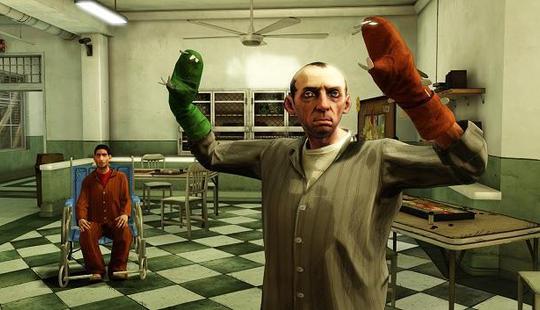
Throughout, the gameplay is of a high standard – what The Darkness II lacks in quantity it makes up for in quality. A few upgrades in and Jackie feels virtually indestructible, with a Darkness-powered shield around him come the later stages which makes even the fiercest assault on his progress seem like a tickle. As enemies wise up to his one weakness – the Darkness powers only work in the shadows – they attempt to blind him with dazzling spotlights before opening fire. But with ammo plentiful, taking the crudest course of action and mowing down these assailants with bullets, rather than heart-devouring demon arms, is just as conducive to advancement. At the top difficultly every clip counts, but slip down a gear to enjoy the story and laying waste to cannon-fodder foes is a breeze. The quick-time finishing moves – which can be upgraded to give Jackie extra energy, or extra ammo, when they’re used – are fun for a while but do become repetitive. Still, it’s not every game that lets you pull someone’s spine out through their backside, and rewards you with a few extra rounds for the trouble.
Here spoilers be, so look away now if you must. The story is generally great, but a major character of the first game is unexpectedly done away with in a most horrific fashion around two-thirds of the way through. While the first game showed the death of Jenny as a catalyst for Jackie to embrace the Darkness powers and take his vengeance, that’s not quite the case here – Jackie’s got the necessary direction and his vision is clear, and the execution of another nearest-and-dearest (and he’s not got many) is perhaps a grizzly misstep of some otherwise exemplary writing, courtesy of Marvel Comics author Paul Jenkins. Also, the ending(s), while sweet, are short by today’s standards. They feel hurried, and neither of the two truly satisfies. Unless you’re familiar with the comics, the role of the (again, spoiler!) end-game-appearing Angelus mightn’t be clear, although in-game encyclopaedia Johnny Powell does his best to blather on about anything and everything Darkness-related.
But despite a few shortcomings, The Darkness II in full flow is a dream to behold – and firing off rounds from dual-wielded pistols while one demon arm grabs a panicking enemy and the other slices a would-be attacker in half is a lot more fun than, say, stalking around sci-fi environments with stealthy grace in the hope that a sentinel robot doesn’t take a liking to opening up your skull. Come the end of 2012 it’s not too likely that this will shine as the year’s finest FPS – but it’s an absolute blast while the rush holds, and its developers should take a bow for being brave with the presentation of this fine-looking title. Plus: who doesn’t want to play a game where Mike Patton’s demanding you feed him vital organs?

Final Fantasy XIII-2
(Square Enix; PlayStation 3, Xbox 360)
Square doesn’t often do direct sequels to its Final Fantasy games, so XIII-2 is very much the exception rather than the norm – and, for the most part, it’s an exceptional chapter in the FF canon, albeit one that perhaps owes its existence to the failings of its preceding title.
The Japanese RPG behemoth has been a mainstay on year-end best-of lists since FFVII lit up the PlayStation back in 1997, but 2009’s XIII wasn’t short of detractors. In an interesting turn of events, though, fans bemoaning its linearity were listened to, and Square have set about righting the wrongs of their last adventure with a refined, refocused sequel. Continuing the story of XIII where it left off, XIII-2 isn’t a game to appeal to series newcomers, such is its complicated and ridiculously convoluted narrative; but those who bought into the world painted so superbly by XIII, only to be let down by some gameplay niggles, are in for a treat.
Everything, outside of the utterly bonkers plot, is better this time around. The Active Time Battle system (pictured, below) is that bit slicker (and it was already decent to begin with), and enemies are randomly generated rather than being visible from a distance, in keeping with FF tradition. The player – assuming the role of either Serah or Noel (more in a moment) – can skirt around competitive encounters; but you’ll want to slay a few nasties to build up your skills in the Crystarium, which has been modified for improved accessibility. Basically, anything that was a headache to understand in the last game has been made that tiny bit more user-friendly; though if any of these terms mean nothing to you, it’s unlikely that FFXIII-2 is the game you should be picking up next.
Additions to the combat are certainly interesting. Quick-time events, labelled Cinematic Action in the top left of the screen, allow for spectacular set pieces that knock multiple hit points off an enemy. Some will find them a nuisance, taking the player away from the ATB set-up that served so well before; but fans of God of War and so many of its QTE-loaded brethren will be right at home with commands to press B repeatedly, or move the stick left to trigger an attack at just the right time. Rather than have three human characters in the thick of things, FFXIII-2 allows the player to add a monster to its team’s ranks – so beside Serah and Noel can be one of three creatures, each with its unique skill-set, during combat. These beasts are collected by bettering them in battle, and it’s important to use them wisely in the Paradigm system, which works in the same way as in FFXIII. Basically, you set up character roles to provide the right combination of abilities for the right situation, and switch between them accordingly – for offensive to defensive, magical to all-guns-blazing.
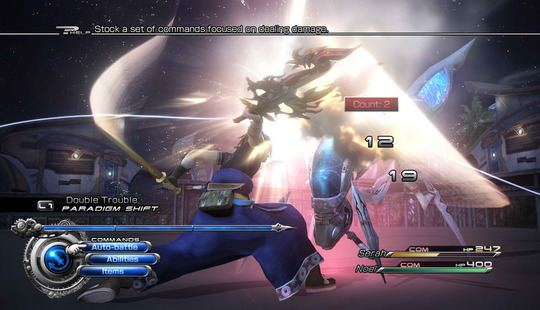
Initially, the player assumes control of Serah, the sister of XIII’s primary protagonist (though that’s dependent on how you played it), Lightning. Lightning is trapped in another dimension, in a future that may or may not come to pass. The hows and whys are explained as the story progresses – and the story is kicked into gear by the arrival in Serah’s present of Noel, a baggy-trouser-sporting sort from the future who’s pretty handy with a pair of blades. The two decide to set out to find Lightning – mainly due to Noel’s insistence that Some Pretty Bad Shit has happened/is happening where she is – and many a location familiar to players of XIII is traversed, albeit at newly experienced points in the game’s complicated history. Time travel is achieved through the Historia Crux System, and around the gates the pair travel through, strange events occur. These are called Paradoxes, and usually end up with a big baddie that needs battering. Sometimes Serah and Noel, and their monster buddies, get trapped between times, in areas called Temporal Rifts. When this happens, puzzles have to be solved – though, mercifully, they’re nowhere near as hard as those of Catherine.
Still with me? Great: this is probably one for you. If none of the above has made any sense, just move along. FFXIII alienated enough fans of the franchise for XIII-2 to be left playing catch-up on the way to acclaim. But the faithful are recommended to stick it out past some laborious prologue scenarios, overlook the occasional NPC model that seems beamed in from FFX (mostly, this looks every inch as gorgeous as XIII), and enjoy the faster-paced action and better open-world gameplay FFXIII-2 offers. It’s less a revelation, more a recalculation of the disparate aspects of Square’s previous effort. But there’s no doubting the team has produced an end product that adds up to rather more than the sum of its slightly archaic-feeling parts. It’s the game XIII might’ve been back in 2009, if it featured fewer cut-scenes and a greater focus on having fun.
Some bad news, though: the dunderheaded fists-flying annoyance of XIII, Snow, is back. But at least he’s changed his clothes, which is more than can be said for his NORA mates. You’d think, what with all that happened in the last game, someone might’ve torn a knee or scuffed an elbow.
Apology: Asura’s Wrath was supposed to be reviewed here, but frankly this is one LONG column as it is. So words on that particular slice of Japanese bonkers-ness will have to wait until March. Sorry.
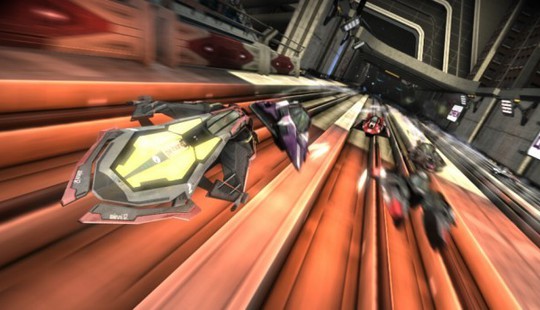
HANDS ON THE MERCH (THIS IS THE HARDWARE BIT)
It may have come to your attention that there’s a new handheld on the domestic market: Sony’s PlayStation Vita (that's it, pictured way up top). I spent a couple of evenings with a preview machine pre-loaded with a handful of games – and this is what I made of the experience.
Looks
The Vita looks exactly like what it is: the next step forwards from Sony’s previous handheld, the PSP. The two machines share aesthetic traits; but the Vita shrinks its buttons (which, it must be said, can make things a little fiddly for the larger-thumbed gamer) and adds an extra stick to the equation. That, and there’s a touch-plate on the rear of the console – on Uncharted: Golden Abyss, this is used to shimmy up and down ropes and spin around various artefacts, to see them from all angles. The crisp five-inch display is a touchscreen, and it delivers some impressive graphics – WipEout 2048 (pictured) features some visuals that truly would not be out of place on this system’s household cousin, the PlayStation 3. The build quality is decent enough, though the plastic bumpers for the player’s left and right index fingers are clear plastic and feel like they might not survive too many intense sessions, and there’s a cheap feel to the Vita card and accessories (such as extra memory… uh oh, additional outlay!) slots – rather than hinge, the covers for these are attached by thin rubber strips, which might not go the distance. The games come on cards rather than discs – not as shiny as the PSP UMDs, but certainly less likely to get smudged by sweaty fingerprints.
Feel
I spent several hours with the Vita and never once felt truly comfortable with it – but perhaps my hands are simply the wrong size (they’re neither large not small, but perhaps some aspect’s out of whack). If you’re used to a PSP, adapting to this slightly larger model won’t be an issue; if you’re new to Sony’s handhelds, though, using an iPhone after a half-hour with this is going to have the Apple device feeling as big as a postage stamp. While it’s portable, obviously, you’d need some pretty generously cut trousers to call the Vita pocket-sized. Also, while playing on the train I noted that my elbows were jutting out a little more than I’d like while holding the Vita – the guy next to me didn’t seem to mind, but still, it’s worth noting that this is very much a two-handed device, and to get up close and personal with it may require taking up two seats the next time you travel.
Battery
Let’s see… When I picked this up, it had about 80% battery. That was down to zilch after about three hours (during which time the Vita never became hot, like some smart phones do during prolonged use). But it charges quickly – an hour in the mains and it looks like the battery is as good as full. Certainly it was full enough to blast through a few more stages of Uncharted, which restarted from the point the battery died – a nice touch there, Sony.
Features
Internet, movies, music: it does all of these things. Facebook, Skype and Twitter (etc) will be available from the PlayStation Store. There are cameras front and back, and a microphone at the bottom of its behind. Several games make use of the built-in gyroscope, which is a three-way beauty (don’t say that out of context) supported by a three-axis accelerometer. It ‘does’ 3G and wi-fi, though if you want one that does the pair at the same time you’re gonna have to cough up some extra notes. To be fair, you could have looked all of this stuff up on Wikipedia, too. So go there if you want to know more about the nuts and bolts.
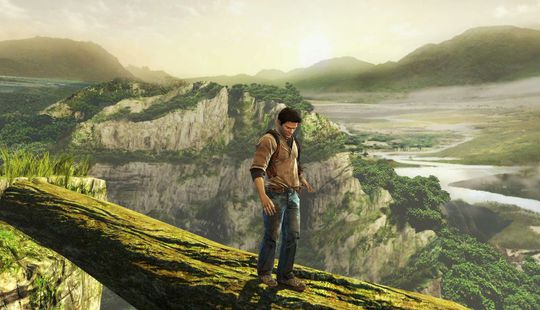
Games
Both WipEout and Uncharted (pictured, above) hold up well to their bigger console predecessors. The former is a perfectly designed prequel to the classic PlayStation (PS1) racer that moves faster than lightning with no obvious lag and makes good use of the combination of traditional button inputs and touchscreen commands. It gets hectic – naturally – but never does the player become lost in a blur of chaos. Everything looks crystal clear, and the soundtrack has been modernised to feature today’s chart-busting electro sorts like deadmau5 and DJ Fresh, alongside some of the outfits whose sounds became iconic on the original WipEout: welcome back Orbital, The Prodigy and The Chemical Brothers. Overall, it’s a retro delight that holds just as much appeal for absolute beginners to the WipEout series.
Uncharted is perhaps a little slim compared to its PS3 forerunners, but it plays as anyone who’s experienced the three celebrated games to date would expect – Nathan Drake runs, jumps, slides, shoots and wisecracks, and the whole thing’s a lot of fun. Chronologically it’s set before Drake’s Fortune, the first PS3 entry released back in 2007 – but you don’t need to know your Uncharted history to enjoy a quality action-adventure with some fine voice acting. Visually it’s not always perfect – but then you realise what’s running the game (and how quietly it’s doing so) and all is forgiven.
Also included in the preview Vita were Everybody’s Golf, Top Darts and Motorstorm RC, all of which waste a bit of time between changes on the Tube; a demo of Gravity Rush, an interesting sort-of platformer with the feel of Bayonetta minus the carnage to it; and Little Deviants, which might be great but I seemed to always get pinned in a corner and beaten to death with my own shoes… or what might as well have been them, since I was at such an early stage of the game that I might as well not have bothered firing it up. Anyway, I’m sure it’s great if you, y’know, work it out. Which leads me to…
Intuitiveness
Now, the best iOS games are those that anyone can pick up and play. Nintendo’s DS made gaming on the go accessible for millions by simplifying its titles and (mostly) promising the player they wouldn’t have to memorise a thousand-beat combo just to tie their character’s shoelaces (there I go with the shoes, again). The Game Boy had Tetris: perhaps the most intuitive game of all time. So where does the Vita sit? Is it a portable for the DS crowd gone dizzy after a session with a 3DS? Something for smart phone users to get into when they’re done on Words With Friends? Or is it aimed at the hardcore console players who’ll happily murder on-screen strangers while calling them names in a language I… I mean they… can’t understand? Erm… It’s the middle of that there Venn diagram, I suppose. It’s not exactly pick-up-and-play simple to get into; but everything’s laid-out nicely, with menus clear and the controls to navigate them second nature (these spaces are called the ‘LiveArea’). As Little Deviants proved to me so mercilessly, just because you’re a dab hand at Street Fighter IV when it suits you doesn’t mean you can immediately handle a game that seems to be aimed at the more casual player.
The Big Question
Which is: what’s the point? And I don’t, yet, have an answer. Someone Tweeted me when I said I had one of these little boxes to play with for a couple of nights, saying it’ll end up in the same bin of forgotten consoles as the Virtual Boy and the 32X. But I’ve still got my 32X, so that’s not forgotten chez Savage (doesn’t work anymore, but I have the games, and one day I’ll buy a new mushroom thing to pop atop my Mega Drive)… And the Virtual Boy...? Okay, that was a bad idea from the start. In strictly handheld circles though, this obviously isn’t going to be on a level with either the Gamate (I had one, don't bother) or Tiger’s game.com; but, it’s hardly likely to become a classic like the Game Boy, or even the Game Gear for that matter – which was a brilliant handheld. Big Sony titles like Killzone and Resistance are coming to the Vita – but these are the kind of games that, really, I’m only ever going to want to play when I’m sat around in my skiddies with a couple of cans of calming lagerbeer close by – if I lose my shit in public, people are going to notice; likewise if I’m walking about without any trews on. Not that the Vita would fit in them, anyway.
Basically: let’s give the Vita time. I’m impressed enough by it to sort of want to get one; but if the best games for it turn out to be from the PSOne classics range… Well, at least we can play Dino Crisis on the toilet.

FANTASTIC FIVE – JOHNNY FOREIGNER
Perennial DiS favourites JoFo, presently promoting their rather nifty latest LP Johnny Foreigner vs Everything, are present and correct for this month’s Fantastic Five feature. In a change to our usual billing, this time it’s a Super Six, as singerguitarist Alexei Berrow and bassistsinger Kelly Southern pick a trio of titles each. Standard drill regards the selections: any machine, any era, any style, just so long as the game’s a personal winner.
This is JoFo’s website, so it is
And here is the DiS review of …vs Everything
Speedball 2 (multiple platforms; Wikipedia)
Alexei: “Speedball 2 is, cramped hands down, the all-time greatest video game ever made, ever. I'm aware how bold that statement is, but it once cost me a job (in Gamestation, but still...) so I'm not backing down now I've gone to the trouble of turning my laptop into an Amiga again. I've literally been playing this for over 60% of my entire life. If football was half as fast, crunchy and post apocalyptic, then maybe I would care about it more and be a Real Man today; instead, I have a Pavlovian reaction of shouting "Ice cream! Ice cream!" in a tinny voice every time I see someone fall over and cut themselves. 2095 is going to be a great year.”
Speedball 2 intro (Amiga version)
Rez (Dreamcast/PS2; Wikipedia)
Alexei: “Rez was a trancey wire-frame synthesia-tastic version of Panzer Dragoon: zoom down a preset path and kill things from all side until yr eyes go blurry and you die. According to the internet, it had both a plotline and a vibrator add-on, neither of which I feel like I missed out on. I once tried to explain to a friend that it was, in both concept and execution, what I imagined a game from the future would be like. He replied: ‘You do smoke a lot of weed, tho.’ And I guess this is a perfect stoner game, just shoot at stuff to make pretty melodies and like, evolve, dude.”
Rez Area 1 (Dreamcast version)
Star Command (iOS)
“Because I wanted to make like a real games journalist and talk about something that isn't even out yet. I haven't been this excited for a game since Vice City was released and I conned my bank past my overdraft to get it. If you've ever played X-com and thought, ‘I wish this was less vicious, easier to understand, and also set in Star-Trek-parody space’, then a) we should be friends and b) if these guys put as much love and thought into the mechanics as they do the animations, this is our game of the year already.”
Star Command on IGN
(Alexei: “Now Kelly will write about her favourite videogames, two of which will probably involving pressing the cover button to hide behind super-detailed photorealistic grey rocks.”)
Bubble Dizzy (multiple platforms; Wikipedia)
Kelly: “Despite the premise being utterly simple (especially by today's standards), one of my all time favourite games is Codemasters’ Bubble Dizzy, for the C64. In the game, you (well, Dizzy, our egg-shaped protagonist) catch bubbles as they rise from the seabed up to the surface, dodging enemies on the way. At the time, it was aesthetically pleasing and damn hard, too (I was eight!), and whilst it had no Ocean load-up music, the soundtrack even today makes me 'ah' out loud. The mere load-up time (cassettes!) should have been a buzz kill; but not even that could deter me from playing hours of the game to the point of joystick-related RSI.”
Bubble Dizzy, level 6 (C64 version)
Grand Theft Auto: San Andreas (PS2, Xbox, Windows; Wikipedia)
Kelly: “Moving onwards and upwards from the C64, I had dalliances with various consoles before eventually winding up with an Xbox. Whilst I mostly played your standard hack-and-slash titles at this point (Baldur's Gate, Brotherhood of Steel, Dynasty Warriors 4) the one game that made me sit back and mouth 'whoa' time and time again was GTA: San Andreas. Never mind the main storyline; I could easily spend hours, if not DAYS, driving around the vast landscapes; equally spending the same amount of time getting fat by eating at burger joints before visiting a gym and getting, well, ripped. And then you could take a string of girl characters on dates, which I guess is weird behaviour for a girl but HECK! YOU COULD DATE IN A GAME (undoubtedly this wasn't a new gaming concept; it was just new to me). Don't get me started on the cheats. Chaos mode was just... bonkers. One of my proudest gaming moments was barricading myself into a strip club and gaining a 6-star wanted level. I never did finish it; I'd always wind up at the airport nicking planes to fly.”
GTA: San Andreas trailer
Left 4 Dead (Xbox 360, Windows, Mac OS; wikipedia)
Kelly: “Now, I don't profess to be a gaming expert, less an expert in zombie games. Au contraire. However, I always felt Left 4 Dead left all other zombie games in its absolute DUST for a few reasons. The ambience and suspense, for one, and how generally creepy it felt; and the 'special infected' zombies, such as the tank, the smoker and my personal favourite, the witch (I still get that feeling of utter dread when the gentle sound of crying and THAT music comes into earshot). Whilst the daytime setting and the absurdity of the new weapons (guitars and frying pans? Really?) detracted from the overall horror in the second instalment of the game, the first scared the bejesus out of me.”
Left 4 Dead intro
Johnny Foreigner tour in March as follows (* with We Are The Physics)…
1/3 – Sheffield, The Harley
3/3 – Derby, The Victoria Inn *
7/3 – Southampton, UNIT
8/3 – Brighton, Green Door Store *
9/3 – Northampton, Labour Club
10/3 – Cheltenham, Frog and Fiddle *
11/3 – Leeds, Brudenell Social Club *
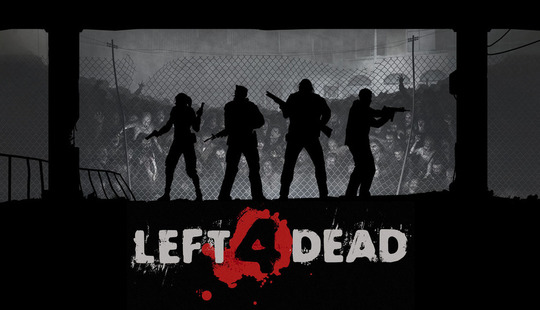
AWESOME GAME ENDING(S) OF THE MONTH
You know: spoilers! The aforementioned Left 4 Dead is an awesome game, so here’s its awesome ending(s) – all four of them. Zombiiiiiiiieeeeeeees…!
Okay, to be fair those aren’t great endings. But to reach just one of them… oh my, such relief.

